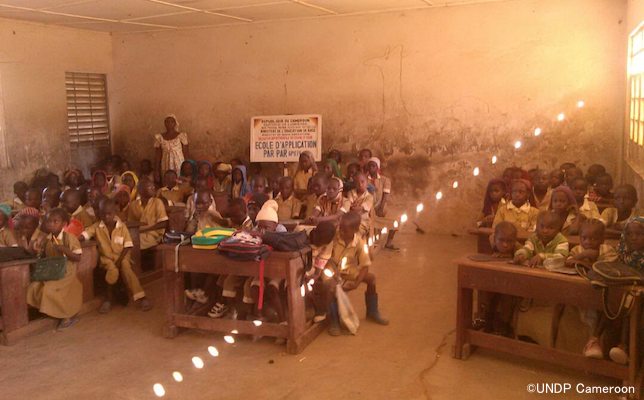2018.07.12News
[Seminar Report] Mainichi Media Café CSR Seminar Bringing Light to People
2018.02.26 News
In 2017, Panasonic donated solar lanterns through the United Nations Development Programme (UNDP) to Cameroon and Nigeria in Africa, and Guyana in South America. These were our first donations to these countries, and this was also our first donation in South America.
Cameroon is blessed with natural resources as well as fertile land for agriculture. Since gaining independence in 1960, the country has maintained political stability compared to the rest of Central Africa, where conflicts are known to occur sporadically. Meanwhile, the recent slowing of its economic growth has led to larger economic disparities within the country. At 62%, Cameroon's national electrification rate is relatively high for Sub-Saharan Africa, although the country has regional disparities, with electrification at 96% in urban areas but only 23% in rural areas.
The far north region of Cameroon is particularly poor, with a poverty rate of approximately 74% and unemployment at over 85%. A look at other social indexes like literacy rate, access to primary education, and maternal mortality, shows that this region faces the harshest conditions in the country. Moreover, most Nigerian refugees and internally displaced persons (IDPs) affected by Boko Haram crisis stay in this region.
The donated solar lanterns will be delivered to 20 elementary schools attended by 6,000 students, and seven vocational training centers hosting 1,500 youths, as well as two health centers, in Logone-Birni sub-division of the Far North region.

An elementary school in Logone-Birni where the solar lanterns are donated
Guyana is the only English-speaking country in South America that is situated on the north eastern region of the continent. The majority of its 750,000 inhabitants reside on the thin coastal plain and the country's electrification rate is estimated at 79%. Many hinterland communities where Guyana's indigenous peoples reside do not have access to an uninterrupted supply of power. The hinterland regions also include Guyana's vast pristine rainforests.. In some parts of the hinterland, electricity is usually available through the use of small generators that would provide energy for about four to eight hours per day. As a consequence, remote communities do not have access a continuous supply of power.
Even though health facilities in the hinterland are powered by photovoltaic systems, the solar lanterns donated, will assist in facilitating medical emergencies during the night. Additionally, these lanterns could be used, at night, to guide the safe landing of light aircraft on small airstrips to evacuate critically-ill patients. Similarly, solar lanterns provided to the education sector will be used to illuminate the school dormitories and study areas of live-in students where such facilities are not powered by the electrical grid or, when the generator sets are turned off, nightly. The lanterns will be used to allow students to continue studying after the generators would have been turned off. It is, therefore, expected that this intervention will contribute to the improvement of students' academic performance.
Photo taken when the solar lanterns arrived
Located in West Africa, Nigeria is Africa's most populated country with approximately 186 million people. The country has witnessed enormous growth in the service industry in recent years, but despite having the highest GDP in Africa, the country suffers from the impacts of fluctuating prices of crude oil, which accounts for a major part of its revenue, as well as declining exchange rates, inflation, and shortages of electricity.
In particular, 8.5 million people in the country's northeast region are in need of emergency aid, including refugees and internally displaced persons (IDPs) who have been forced from their homes. The region has very low electrification in comparison to the 45% national rate. For example, the recent donation recipient states of Borno, Yobe, and Adamawa have electrification rates of only 33%, 16.1%, and 37.6%, respectively.
The solar lanterns will be distributed to public facilities in communities in these three states where IDPs and returnees live, as well as households without access to electricity. The solar lanterns will promote gender equality through priority distribution that promotes increased income for households where the finances are supported solely by a female member, or to alleviate economic inequality by increasing income, by enabling people to work under a light at night.

Internally displaced persons living at schools where they have evacuated. The schools have no electricity.
As with the three recent recipient countries, there are still major regional disparities in Africa and South America. Even if electrification rates are not low on a national level, many people still live without electricity. Panasonic will continue working with UN organizations and non-governmental organizations to provide the necessary support to local communities.